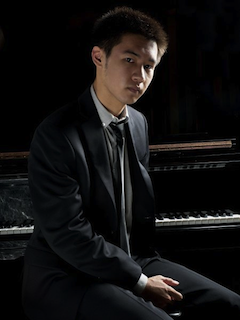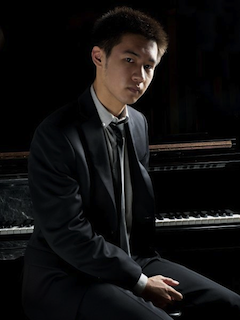
To pair Beethoven’s First Piano Concerto of the late 1790s with the “Scottish” Symphony that Mendelssohn began to think about in 1829 (as a youth) and finished in 1842 (as an avatar) is to draw sharp attention to musical Romanticism in central Europe before it engorged and at length engulfed itself. At the Sacramento Philharmonic Orchestra’s Saturday concert conducted by Michael Morgan, the soloist’s encore, too — and the notion of giving an encore at all — planted us firmly on Romantic soil. The concert likewise focused the mind on prodigy and the question of finding a true and mature voice.
Conrad Tao, a good deal shy of 20, anchored the first half of an inviting program as soloist in Beethoven’s First Piano Concerto and as composer of the opening work, Pángǔ. In both capacities he’s mightily impressive. So is his resume to date, which includes an exclusive EMI recording contract, a wall-full of honors and distinctions like a Forbes “30 under 30” nomination in music (alongside Lady Gaga and Justin Bieber), Ph.D. scientists for parents, and simultaneous matriculation at Juilliard and Columbia. (I couldn’t help wondering about midterms, this being the season.)
Tao has a deft touch, considerable tact for one so gifted, and sure musical instincts. Tao may well be at “The Vulnerable Age,” as New York magazine’s Justin Davidson had it in an article last March, observing (rightly) that it’s a little early to predict what will happen next and that the trajectory for such people is fraught. But in Sacramento’s Community Center Theater the meteor was unquestioningly ascendant.
For one thing it was a thorough pleasure to hear a live performance of Beethoven’s First Piano Concerto at all, so dominant are his Third, Fourth, and Fifth. Here the military figures in the first movement draw our thoughts strongly to Viennese precedents, notably K. 503, while any number of passages signal the impending new style. (I missed the wonderful fall from the C major of the first movement to A-flat in the second, owing to a burst of applause followed by some crowd-control issues on my side of the house.)
The orchestral enterprise in Sacramento is often a thing to admire.
The first fortissimo tuttis were unbearably loud, wiping out the front half of the players (and why was an assisting hornist needed here?), but subsequently a more refined, one might say Classical, approach gained sway. Tao’s account of the solo part, too, recognized its Mozartean lineage, especially in the seamless voicing. Its brilliance lay in the nuance: a hint of crescendo here, the suggestion of rallentando there. He chose the longest of the three Beethoven cadenzas — the one with the zany chromatics and uncomfortable fakery as pianist and orchestra reunite; the one that to my ear throws the argument well off balance — and very nearly made it work.
I heartily approved of the encore, Liszt’s Hungarian Rhapsody No. 6 in D-flat, with the ricochet octaves. So did the audience.
Pangu, who emerged from the primeval ooze of yin and yang, is the central character of the Chinese creation myth. Conrad Tao’s 10-minute evocation (for full-ish orchestra, with low brass and percussion) is straightforward, perhaps a little obvious, in its three-part construction. From a foundation of busy homophonic passagework in the strings — think Petrushka — emerge the controlling intervals and melodic cells. Pangu breaks from his shell and proceeds to separate out the Earth from the heavens: I took this to be represented by the big climax and decrescendo into a slower center section with brass chorale and some clever licks for solo bassoon. The substance of the first section returns, though now the metric fabric is less regular. “In this heterogeneity,” writes the composer, “is a beautiful unity, a cohesion made up by contrasting parts. The earth and the sky need each other.”
Audience and musicians alike were riveted by the virtuosity of a very young man captivating them much as Liszt himself might have done.
The work was, like Tao’s playing, intuitively musical, keenly sensitive to orchestral sonority, and a capably eclectic response to the musics that naturally have surrounded a prodigy of his age and upbringing. Were he to ask, I’d recommend rigorous old-school counterpoint lessons.
The Mendelssohn Sound
But what has lingered longest in the ear is the warm-hued palette of sounds to have been heard in the slow movement of both the Beethoven and the Mendelssohn. The clarinet-bassoon-horn work in the Largo of the concerto and the wind choirs in the reprise and coda of the symphony’s slow movement were consistently lovely. (Beethoven’s wind scoring in this concerto is eccentric: The clarinets sit out much of the first movement; flute and oboes are tacet in the second.) A near-perfect registration in the Mendelssohn Adagio, with the tender serenade of lyric melody over (and under) pizzicatos from the inner strings, was the evening’s highlight.
I attributed this, in part, to the modest size of the performing force, allowing a kind of transparency that serves the Mendelssohn and Schumann symphonies well. (Mendelssohn’s own Gewandhaus Orchestra numbered in the mid-40s; here there were 50 or so.) The second-movement scherzo got at the essence of Mendelssohn’s elfin manner; the splendid opening rip from the solo clarinet went on to earn her a solo bow. The performance prompted all manner of reflection on distribution and balance: How, for instance, might one tame the big modern French horn for this repertoire? And can the Mendelssohn sound properly coalesce in so big a room? In the end, though, there was no denying a very close encounter with proper Mendelssohn.
I attributed my satisfaction, too, to the longevity of this particular band, many of whom first came west in the hey-day of the Sacramento Symphony and who have been playing together now for more than three decades. Despite collapses and reemergences and too-frequent arrivals at the brink, the orchestral enterprise in Sacramento is often a thing to admire. The Phil is in its 16th season; Music Director Michael Morgan, in his 14th, is as much a fixture in the Valley as in the Bay Area. He is off now to France to lead the European premiere of the Dave and Chris Brubeck work Ansel Adams: America, born and bred in Northern California.
The tableau that closed the first half of the program was the stuff of Romanticism writ large: audience and musicians alike riveted by the virtuosity of a very young man captivating them much as Liszt himself might have done. From stage right, behind the violins, Morgan stood proud and motionless, drinking in the moment. But there was no hiding the twinkle in his gaze.

